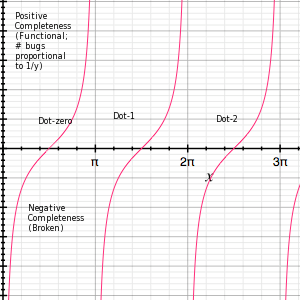Trigonometric Programming: The tangent function & Software Development

Blocked waiting for my either the software development group to give me new code to test or my FreeBSD build VM to give me a new OS build to test, so how about some random thoughts on programming?
I've reached the inescapable conclusion that all software development cycles can be expressed as a single equation: y=tan(x+(π/2))
X represents time (on a totally non-linear scale) with each interval of width π being the development of a software release and the zero point where the function crosses the X axis representing the release of the X/πth version. The Y axis represents the state of the code - how "bug free" it is. I'll call the Y value within a version the "completeness" of the code for simplicity.
This functional model actually works surprisingly well:

- During pre-0.0 release (X|0...π/2) the software is riddled with bugs and brokenness ("completeness" is negative - that shit don't work!).
- At some point (X=(π+ε)/2) the software becomes at least functional (miniscule positive completeness), and is released to the unsuspecting public.
- The initial release is buggy as shit, and massive patching and bug fixing happens
(This is roughly from X|(π+ε)/2...3π/2 -- For the sake of argument let's call the 3π/2 mark the .1 release, or in MS parlance, "Service Pack 1") - The software continues asymptotically approaching infinite completeness -- that nirvana state of having no bugs...
- ...At which point Marketing comes along and says the users want new features -- On our graph this corresponds to one of the vertical asymptote at multiples of π.
- Development begins on the next (N/π)-dot-zero release, starting al over again from negative completeness.
In practical terms software development is not a true function: Each development window is independent and shifted toward X=0, with some overlap between the currently released version and the version under development.